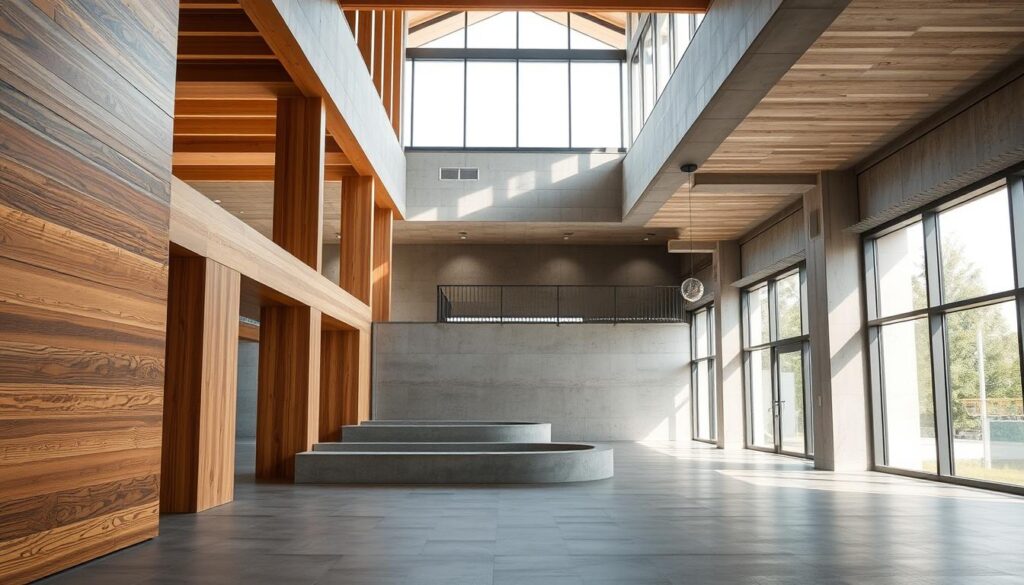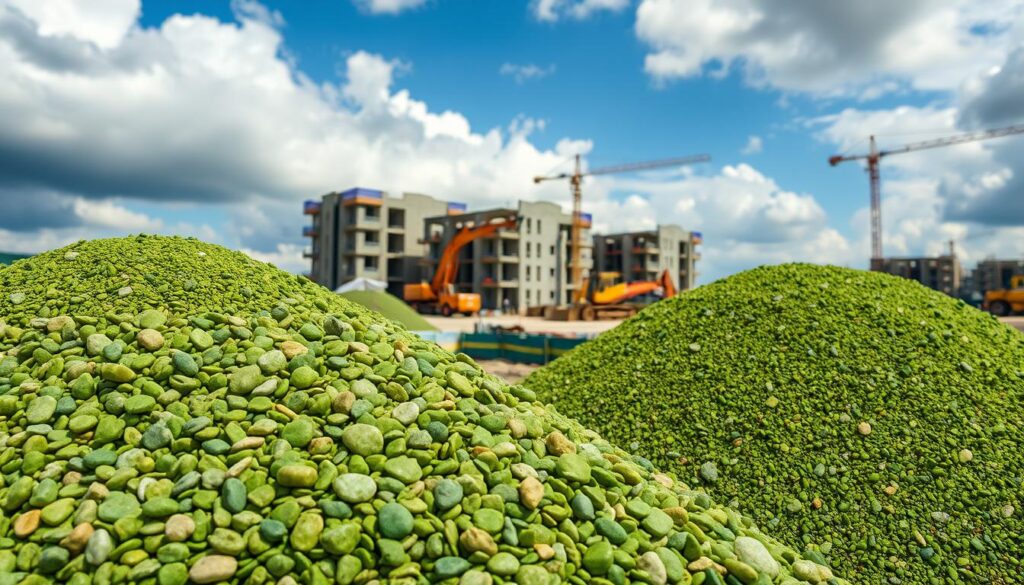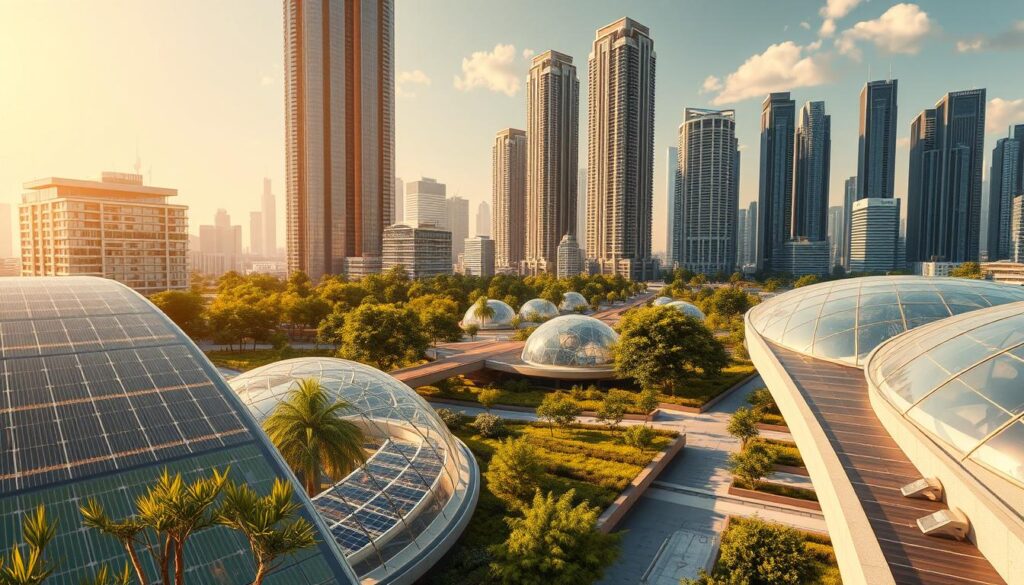The construction industry is one of the largest consumers of natural resources and contributors to environmental degradation. A startling fact is that buildings account for nearly 40% of global energy consumption, highlighting the urgent need for sustainable practices in civil engineering.
The use of green building materials is crucial in reducing the environmental footprint of construction projects. These materials not only minimize waste and pollution but also promote energy efficiency and sustainability.
As the world shifts towards green infrastructure, understanding the benefits and applications of eco-friendly materials is essential for civil engineers and builders.
Key Takeaways
- Eco-friendly materials reduce environmental impact.
- Green building materials promote energy efficiency.
- Sustainable practices are crucial in modern construction.
- The use of green materials minimizes waste and pollution.
- Understanding eco-friendly materials is essential for civil engineers.
Introduction to Sustainable Civil Engineering
As concern for the environment grows, sustainable civil engineering has become a critical aspect of modern construction. This field focuses on reducing the environmental impact of construction projects through the use of eco-friendly materials and practices.
Overview of Sustainable Practices
Sustainable practices in civil engineering involve the use of materials that are renewable, recyclable, and have minimal environmental impact. For instance, materials like bamboo, cork, and recycled steel are gaining popularity due to their eco-friendly properties. Dr. Raviteja K’s work on sustainable materials in civil infrastructure highlights the growing importance of this field.
The adoption of sustainable practices not only benefits the environment but also enhances the durability and efficiency of construction projects. For example, using recycled materials can reduce waste and lower production costs.
Importance of Sustainable Materials
Sustainable materials play a crucial role in reducing the carbon footprint of construction projects. They are designed to be energy-efficient and minimize environmental harm. The use of such materials is becoming increasingly important as the world moves towards greener infrastructure.
The benefits of sustainable materials can be seen in various aspects, including environmental impact, cost-effectiveness, and health and safety advantages. The following table summarizes some key benefits:
| Benefits | Description |
|---|---|
| Environmental Impact | Reduced carbon footprint and minimal environmental harm |
| Cost-Effectiveness | Lower production costs and long-term savings |
| Health and Safety | Improved indoor air quality and reduced toxicity |
By incorporating sustainable materials into civil engineering projects, we can create infrastructure that is not only environmentally friendly but also cost-effective and safe for users.
Types of Sustainable Materials in Civil Engineering

The use of eco-friendly construction materials is becoming increasingly prevalent in civil engineering projects. As the industry moves towards sustainable infrastructure solutions, the demand for environmental friendly construction materials is on the rise.
Recycled Materials
Recycled materials are gaining traction in civil engineering due to their potential to reduce waste and conserve natural resources. For instance, recycled steel is being used in construction projects for its strength and durability. Similarly, reclaimed wood is valued for its unique aesthetic and environmental benefits.
Renewable Resources
Renewable resources such as bamboo and cork are becoming popular in sustainable construction. Bamboo, with its high strength-to-weight ratio, is ideal for structural applications. Cork, on the other hand, is used for its insulation properties and sustainability.
According to experts, “The use of renewable resources in construction not only reduces the environmental footprint but also enhances the sustainability of the built environment.”
“Sustainability is no longer a choice but a necessity in modern construction.”
Locally Sourced Materials
Locally sourced materials are another crucial aspect of sustainable civil engineering. By sourcing materials locally, construction projects can reduce transportation emissions and support local economies. For more information on sustainable building materials, visit World Civil Society.
In conclusion, the integration of recycled materials, renewable resources, and locally sourced materials is pivotal in advancing sustainable infrastructure solutions. As the civil engineering sector continues to evolve, the adoption of these materials is expected to play a critical role in shaping the future of eco-friendly construction.
Benefits of Using Eco-Friendly Materials
The use of eco-friendly materials in construction is revolutionizing the way we build, offering numerous benefits for the environment, economy, and public health. As we continue to develop and implement sustainable urban development materials, it’s essential to understand the advantages they bring to the table.
Environmental Impact
Eco-friendly materials significantly reduce the environmental footprint of construction projects. By using materials with low VOC emissions and sustainable insulation, we can minimize the negative impact on the environment. For instance, materials like recycled glass aggregate and crushed brick aggregate not only reduce waste but also conserve natural resources.
The environmental benefits are multifaceted, including reduced greenhouse gas emissions, conservation of water, and decreased pollution. By opting for green infrastructure materials guide recommendations, builders can contribute to a healthier ecosystem.
Cost-Effectiveness in the Long Run
While the initial cost of eco-friendly materials might be higher, they offer significant cost savings over time. Durable and sustainable materials reduce maintenance and replacement costs, leading to long-term financial benefits. For example, using permeable pavement systems can reduce stormwater management costs.
Moreover, many governments offer incentives for using eco-friendly materials, such as tax credits or grants, which can offset the initial investment. This makes the adoption of sustainable materials not only environmentally friendly but also economically viable.
Health and Safety Advantages
Eco-friendly materials also play a crucial role in improving indoor air quality and overall health and safety. Materials with low VOC emissions, for instance, reduce the risk of respiratory problems and other health issues associated with poor indoor air quality.
Furthermore, sustainable materials can enhance the safety of buildings by providing better insulation, reducing the risk of mold growth, and minimizing the use of hazardous chemicals. This creates a healthier and safer environment for occupants.
Concrete Alternatives for Green Infrastructure

Sustainable civil engineering is witnessing a rise in the use of alternative materials to traditional concrete for green infrastructure. As the industry continues to evolve, it’s essential to explore the benefits and applications of these innovative materials.
Traditional concrete has been a cornerstone of construction for centuries, but its production is associated with significant environmental impacts, including high carbon emissions and resource depletion. In response, the industry is turning to alternatives that not only reduce these impacts but also offer improved performance and sustainability.
Fly Ash Concrete
Fly ash concrete is a sustainable alternative that incorporates fly ash, a by-product of coal combustion, into the concrete mix. This substitution can significantly reduce the amount of cement required, thereby lowering the carbon footprint of the concrete. According to a study on sustainable construction practices, fly ash concrete can reduce greenhouse gas emissions by up to 30% compared to traditional concrete.
Hempcrete
Hempcrete, made from hemp fibers and a lime-based binder, is another innovative material gaining traction in green infrastructure projects. It offers excellent insulation properties, is lightweight, and has a negative carbon footprint since hemp absorbs CO2 during its growth. Hempcrete is particularly useful for non-load-bearing walls and insulation.
Reclaimed Concrete Aggregate
Reclaimed concrete aggregate (RCA) is produced by recycling concrete from demolition sites and construction waste. Using RCA in new concrete mixes reduces the need for virgin aggregates, decreases waste sent to landfills, and lowers the environmental impact associated with extracting and processing raw materials.
The adoption of these concrete alternatives is crucial for advancing sustainable construction practices and green building technology. By integrating materials like fly ash concrete, hempcrete, and reclaimed concrete aggregate into infrastructure projects, the construction industry can significantly reduce its environmental footprint while promoting sustainable development.
Sustainable Asphalt and Pavement Solutions
The shift towards sustainable infrastructure has led to the development of innovative asphalt and pavement solutions. As the construction industry continues to evolve, the focus on reducing environmental impact has become paramount. Sustainable asphalt and pavement solutions are being adopted to minimize the ecological footprint of infrastructure projects.
There are several key technologies and materials driving this change. These include:
- Recycled Asphalt Pavement (RAP): RAP involves reusing existing asphalt materials from old pavements, reducing the need for virgin aggregates and lowering the environmental impact of asphalt production.
- Warm Mix Asphalt: Warm Mix Asphalt is produced at lower temperatures than traditional hot mix asphalt, resulting in lower energy consumption and reduced emissions.
- Porous Pavement Systems: Porous pavements allow water to percolate through the surface, reducing stormwater runoff and improving water quality.
Recycled Asphalt Pavement (RAP)
RAP is a highly effective method for reducing waste and conserving natural resources. By reusing existing asphalt materials, the need for new raw materials is significantly decreased. According to the Asphalt Pavement Alliance, RAP can reduce the amount of virgin asphalt required in new pavements, thus lowering costs and environmental impact.
Warm Mix Asphalt
Warm Mix Asphalt technology has gained popularity due to its ability to reduce production temperatures, resulting in lower fuel consumption and decreased greenhouse gas emissions. This technology also improves working conditions by reducing fume emissions, making it a healthier option for construction workers.
Porous Pavement Systems
Porous Pavement Systems are designed to manage stormwater runoff by allowing water to infiltrate the pavement surface. This not only reduces the burden on drainage systems but also helps to recharge groundwater. Porous pavements can be made from various materials, including porous asphalt, pervious concrete, and permeable interlocking pavers.
For more information on sustainable practices in civil engineering and project management, visit World Civil Society.
Green Aggregates for Construction Projects

As the demand for sustainable construction materials grows, green aggregates are emerging as a vital component in the development of eco-friendly infrastructure.
Green aggregates are materials used in construction that offer environmental benefits over traditional aggregates. They are derived from various sources, including recycled materials and industrial by-products.
Recycled Glass Aggregate
Recycled glass aggregate is made from post-consumer glass waste that is processed into a usable form for construction. This material not only reduces landfill waste but also conserves natural resources.
The use of recycled glass aggregate in construction projects has several benefits, including:
- Reduced waste in landfills
- Conservation of natural resources
- Potential for improved drainage due to its porous nature
Crushed Brick Aggregate
Crushed brick aggregate is another sustainable option, derived from demolished brick structures. It can be used as a substitute for traditional aggregates in various construction applications.
The benefits of using crushed brick aggregate include:
- Reduced need for virgin materials
- Lower carbon footprint compared to producing new bricks
- Potential for improved thermal mass in buildings
Industrial By-product Aggregates
Industrial by-product aggregates are derived from various industrial processes, such as slag from steel production or coal combustion by-products. These materials can be processed into aggregates that meet construction standards.
The use of industrial by-product aggregates offers several advantages:
- Reduced waste from industrial processes
- Conservation of natural aggregate resources
- Potential for improved durability in certain applications
To illustrate the benefits and characteristics of these green aggregates, let’s examine a comparison table:
| Aggregate Type | Source | Environmental Benefit | Typical Application |
|---|---|---|---|
| Recycled Glass Aggregate | Post-consumer glass waste | Reduces landfill waste | Drainage layers, landscaping |
| Crushed Brick Aggregate | Demolished brick structures | Conserves natural resources | Road base, concrete production |
| Industrial By-product Aggregates | Industrial processes (e.g., slag, coal combustion by-products) | Reduces industrial waste | Concrete production, road construction |
In conclusion, green aggregates such as recycled glass aggregate, crushed brick aggregate, and industrial by-product aggregates offer significant environmental benefits and can be effectively used in various construction projects.
Innovative Bio-based Materials
Innovative bio-based materials are revolutionizing the construction sector with sustainable alternatives. These materials not only reduce the environmental footprint of construction projects but also offer unique properties that can enhance the durability and efficiency of buildings.
Bamboo as a Building Material
Bamboo is gaining popularity as a sustainable building material due to its high strength-to-weight ratio, flexibility, and rapid growth rate. It is particularly useful for structural applications, such as beams and columns, and can also be used for flooring and wall cladding. Notable civil engineering companies are now incorporating bamboo into their projects.
Mycelium-Based Products
Mycelium-based products, derived from the root structure of fungi, are another innovative bio-based material. They can be used to create sustainable insulation, packaging materials, and even building components. Mycelium-based materials are biodegradable, non-toxic, and have excellent thermal insulation properties. For more information on sustainable materials, research papers like the one on sustainable construction practices provide valuable insights.
Bio-composites in Construction
Bio-composites, made from a combination of natural fibers and bio-based resins, offer a sustainable alternative to traditional composite materials. They are used in various construction applications, including roofing, wall panels, and structural components. Bio-composites can reduce the reliance on petroleum-based materials and lower the carbon footprint of construction projects.
| Material | Properties | Applications |
|---|---|---|
| Bamboo | High strength, flexibility, rapid growth | Structural beams, flooring, wall cladding |
| Mycelium-Based | Biodegradable, non-toxic, good insulation | Insulation, packaging, building components |
| Bio-composites | Sustainable, reduced carbon footprint | Roofing, wall panels, structural components |
Water Conservation and Management Materials

Effective water conservation and management are crucial for sustainable infrastructure solutions. As urbanization continues to grow, the need for innovative materials and systems that can manage water resources efficiently becomes increasingly important.
Various environmental friendly construction materials are being utilized to address water conservation challenges. These include permeable pavement, green roof systems, and rainwater harvesting solutions, each offering unique benefits and applications.
Permeable Pavement
Permeable pavement is a revolutionary material that allows water to percolate through the surface, reducing runoff and filtering out pollutants. This not only helps in recharging groundwater but also mitigates the risk of flooding. According to the UNEP-DHI report, permeable pavement is an effective strategy for managing urban stormwater runoff.
The use of permeable pavement is becoming increasingly popular in urban areas. It is made from porous materials that enable water to pass through, thereby reducing the burden on drainage systems.
Green Roof Systems
Green roof systems are another innovative solution for water conservation. By covering rooftops with vegetation, these systems absorb rainwater, reduce runoff, and provide insulation, thereby lowering energy consumption. As noted by experts, “Green roofs can retain up to 70% of rainfall, significantly reducing stormwater runoff.”
Green roofs also offer additional benefits, including improved air quality and creation of habitats for wildlife. They can be implemented in various settings, from residential buildings to commercial complexes.
Rainwater Harvesting Solutions
Rainwater harvesting solutions involve collecting and storing rainwater for later use. This practice reduces the demand on municipal water supplies and decreases stormwater runoff. Rainwater can be used for irrigation, toilet flushing, and even drinking water, provided it is properly treated.
Implementing rainwater harvesting systems requires careful planning, including the design of storage tanks and treatment processes. However, the benefits of water conservation and reduced utility bills make it a worthwhile investment.
In conclusion, materials and systems like permeable pavement, green roof systems, and rainwater harvesting solutions play a vital role in water conservation and management. By incorporating these sustainable infrastructure solutions into our construction practices, we can significantly reduce water waste and promote a more sustainable future.
Energy-Efficient Building Materials
As the world shifts towards greener practices, energy-efficient building materials are becoming a crucial component of modern construction. The focus on reducing energy consumption and environmental impact has led to the development and adoption of various innovative materials and technologies.
Insulating Concrete Forms (ICFs)
Insulating Concrete Forms (ICFs) are a sustainable building solution that provides excellent thermal insulation, reducing the need for heating and cooling. ICFs are made from insulating materials that are molded to form the shape of the building, into which concrete is poured. This results in a highly energy-efficient building envelope. According to the Pacific Northwest National Laboratory, ICFs can significantly reduce energy consumption in buildings.
The benefits of ICFs include improved energy efficiency, reduced noise pollution, and increased durability. They also offer design flexibility, allowing for the creation of complex building shapes. “ICFs represent a significant advancement in building technology, offering a sustainable solution that meets both energy efficiency and structural integrity requirements,” says an industry expert.
Energy-Efficient Windows
Energy-efficient windows are another critical component of sustainable building design. These windows are designed to minimize heat transfer between the inside and outside of a building, reducing the need for artificial heating and cooling. Technologies such as double or triple glazing, low-e coatings, and gas fills between panes enhance their energy efficiency.
For more information on reducing construction costs, which can be affected by the choice of windows, visit World Civil Society. The use of energy-efficient windows not only reduces energy consumption but also improves occupant comfort by minimizing drafts and reducing heat gain during summer.
Cool Roofs
Cool roofs are designed to reflect more sunlight and absorb less heat than traditional roofs, thereby reducing the temperature inside buildings. This can lead to significant energy savings, especially in warmer climates. Cool roofs can be achieved through the use of specialized coatings, materials, or membranes that are designed to be highly reflective.
The benefits of cool roofs include reduced energy consumption for cooling, extended roof lifespan due to reduced thermal stress, and mitigation of the urban heat island effect. As noted by a recent study, “cool roofs can reduce cooling energy consumption by up to 20% in some climates.”
In conclusion, energy-efficient building materials such as ICFs, energy-efficient windows, and cool roofs play a vital role in reducing energy consumption and promoting sustainability in the construction industry. By adopting these materials and technologies, builders and architects can create buildings that are not only environmentally friendly but also cost-effective in the long run.
Sustainable Wood and Timber Options

In the quest for greener infrastructure, sustainable wood and timber options are emerging as viable alternatives to traditional materials. These materials not only reduce the environmental footprint of construction projects but also offer a range of benefits, from cost savings to improved structural performance.
Certified Wood Products
Certified wood products are sourced from forests that are managed responsibly, ensuring that the wood is harvested in a way that minimizes environmental impact. The most recognized certification is the Forest Stewardship Council (FSC) label. Using certified wood products supports sustainable forestry practices and can enhance the market value of a construction project.
Benefits of Certified Wood Products:
- Ecological sustainability
- Support for responsible forestry
- Enhanced market value
Engineered Lumber
Engineered lumber is made by combining wood fibers or veneers with adhesives to form a composite material. This process allows for the creation of structural elements that are stronger, more stable, and less prone to warping than traditional lumber. Engineered lumber can be used in a variety of applications, including beams, joists, and studs.
Advantages of Engineered Lumber:
- Increased strength and stability
- Reduced waste during production
- Versatility in design and application
Cross-Laminated Timber (CLT)
Cross-laminated timber (CLT) is a type of engineered wood product made by layering wood boards in alternating directions and bonding them together with adhesive. CLT is known for its high strength-to-weight ratio, fire resistance, and aesthetic appeal. It is used in a variety of construction projects, from residential buildings to large commercial complexes.
| Material | Sustainability Features | Common Applications |
|---|---|---|
| Certified Wood Products | Ecological sustainability, support for responsible forestry | Framing, decking, flooring |
| Engineered Lumber | Increased strength, reduced waste | Beams, joists, studs |
| Cross-Laminated Timber (CLT) | High strength-to-weight ratio, fire resistance | Building frames, walls, floors |
Composite Materials for Sustainable Design
Composite materials are at the forefront of sustainable design, offering innovative solutions for green infrastructure. These materials are engineered to combine the benefits of different substances, resulting in products that are stronger, more durable, and environmentally friendly.
Fiber-Reinforced Polymers (FRP)
Fiber-Reinforced Polymers (FRP) are a type of composite material that has gained significant attention in the construction industry. FRP is made by combining fibers (such as glass, carbon, or aramid) with a polymer matrix. This combination results in a material that is not only strong and lightweight but also resistant to corrosion and fatigue.
Benefits of FRP include its high strength-to-weight ratio, durability, and resistance to environmental degradation. These characteristics make FRP an ideal material for various applications, including bridge construction, building reinforcement, and marine structures.
Recycled Plastic Composites
Recycled plastic composites are another innovative solution in sustainable design. These composites are made by recycling plastic waste and combining it with other materials to create a durable and versatile product. The use of recycled plastic composites helps reduce plastic waste in landfills and conserves natural resources.
The advantages of recycled plastic composites include their sustainability, resistance to rot and insect damage, and low maintenance requirements. They are commonly used in decking, fencing, and other outdoor applications.
Natural Fiber Composites
Natural fiber composites are made by combining natural fibers (such as hemp, flax, or sisal) with a binding agent. These composites are biodegradable, renewable, and have a lower carbon footprint compared to traditional synthetic materials.
Natural fiber composites are used in various applications, including automotive parts, building insulation, and acoustic panels. Their key benefits include improved thermal and acoustic insulation, sustainability, and reduced environmental impact.
| Composite Material | Key Benefits | Common Applications |
|---|---|---|
| Fiber-Reinforced Polymers (FRP) | High strength-to-weight ratio, durability, resistance to corrosion | Bridge construction, building reinforcement, marine structures |
| Recycled Plastic Composites | Sustainability, resistance to rot and insect damage, low maintenance | Decking, fencing, outdoor applications |
| Natural Fiber Composites | Biodegradable, renewable, lower carbon footprint | Automotive parts, building insulation, acoustic panels |
In conclusion, composite materials like FRP, recycled plastic composites, and natural fiber composites are revolutionizing sustainable design in the construction industry. Their unique properties and benefits make them ideal for a wide range of applications, contributing to more sustainable and environmentally friendly infrastructure.
Life Cycle Assessment of Sustainable Materials

Understanding the life cycle assessment (LCA) of materials is essential for adopting sustainable construction practices that minimize environmental footprint. LCA is a methodology that evaluates the environmental impacts of a material throughout its entire life cycle, from raw material extraction to end-of-life disposal or recycling.
Understanding Life Cycle Analysis (LCA)
LCA is a comprehensive tool that assesses various environmental impacts, including energy consumption, greenhouse gas emissions, water usage, and waste generation. It helps in identifying areas where improvements can be made to reduce the environmental footprint of construction projects.
“LCA is a critical tool for evaluating the sustainability of materials and designs. It provides a holistic view of the environmental impacts associated with a product or system throughout its life cycle.” –
Tools for Assessing Material Sustainability
Several tools and methodologies are available for conducting LCA. Some of the prominent ones include:
- Life Cycle Assessment Software (e.g., SimaPro, GaBi)
- Environmental Product Declarations (EPDs)
- Material-specific databases (e.g., USLCI, ecoinvent)
These tools facilitate the assessment of sustainable infrastructure solutions by providing detailed insights into the environmental performance of materials.
| Tool | Description | Application |
|---|---|---|
| SimaPro | LCA software for assessing environmental impacts | Used in various industries for LCA studies |
| EPDs | Documents providing life-cycle environmental impact data | Used for comparing environmental performance of products |
| USLCI | Database containing life cycle inventory data for US products | Used in LCA studies for North American products |
Case Studies on LCA in Civil Engineering
Numerous case studies have demonstrated the application of LCA in civil engineering projects. For instance, a study comparing traditional concrete with alternative materials like fly ash concrete showed significant reductions in greenhouse gas emissions. Such studies underscore the importance of LCA in guiding sustainable construction practices.
In conclusion, LCA is a vital tool for assessing the sustainability of materials used in civil engineering. By understanding and applying LCA, professionals can make informed decisions that contribute to sustainable infrastructure solutions.
Challenges in Adopting Sustainable Materials
Despite the advantages of sustainable materials, their implementation in green infrastructure projects is hindered by several factors. The adoption of environmental friendly construction materials is crucial for reducing the environmental impact of construction activities, but it faces numerous challenges.
Economic Considerations
One of the primary challenges is the economic viability of sustainable materials. Often, these materials are more expensive than their traditional counterparts, making them less attractive to budget-conscious projects. However, it’s essential to consider the long-term benefits and cost savings that sustainable materials can offer.
Cost Comparison: A detailed analysis of the costs associated with traditional materials versus sustainable materials can help in understanding the economic implications.
| Material Type | Initial Cost | Long-term Savings |
|---|---|---|
| Traditional Materials | Lower | Minimal |
| Sustainable Materials | Higher | Significant |
Material Performance vs. Sustainability
Another challenge is balancing material performance with sustainability. While sustainable materials offer environmental benefits, they must also meet performance standards. Innovations in material science are helping to bridge this gap, but it remains a significant consideration.
Case Study: The use of recycled glass aggregate in pavement construction is an example where sustainability and performance are balanced, offering both environmental benefits and durability.
Regulatory Barriers
Regulatory frameworks can also pose a barrier to the adoption of sustainable materials. Existing building codes and standards often favor traditional materials, making it challenging to incorporate innovative, sustainable solutions.
- Updating regulatory frameworks to include sustainable materials
- Incentivizing the use of green infrastructure materials
- Educating stakeholders about the benefits of sustainable materials
Addressing these challenges requires a multi-faceted approach, including education, innovation, and policy changes. By understanding and overcoming these barriers, we can accelerate the adoption of sustainable materials in civil engineering and construction.
Future Trends in Sustainable Civil Engineering Materials

The future of sustainable civil engineering materials is poised to be shaped by emerging technologies. As the construction industry continues to evolve, the integration of sustainable practices and materials is becoming increasingly important. This shift is driven by the need to reduce environmental impact, improve energy efficiency, and promote sustainable urban development.
Emerging Technologies
Emerging technologies are playing a crucial role in the development of sustainable civil engineering materials. Innovations such as advanced recycling techniques, green building technology, and the use of bio-based materials are transforming the industry. For instance, the use of recycled materials in construction projects is becoming more prevalent, reducing waste and conserving natural resources.
Innovations in Material Science
Innovations in material science are leading to the development of new sustainable materials with enhanced properties. For example, the use of mycelium-based products and bio-composites is gaining traction due to their potential to reduce environmental impact. These materials offer improved durability, energy efficiency, and aesthetic appeal, making them ideal for sustainable construction projects.
Policy Changes Supporting Sustainability
Policy changes are also supporting the adoption of sustainable civil engineering materials. Governments around the world are implementing regulations and incentives to encourage the use of green building technologies and sustainable materials. These policies are driving innovation and adoption in the construction industry, paving the way for a more sustainable future.
| Trend | Description | Impact |
|---|---|---|
| Emerging Technologies | Advanced recycling, green building technology | Reduced environmental impact, improved energy efficiency |
| Innovations in Material Science | Mycelium-based products, bio-composites | Enhanced durability, aesthetic appeal |
| Policy Changes | Regulations, incentives for sustainability | Increased adoption of sustainable practices |
In conclusion, the future of sustainable civil engineering materials is bright, with emerging technologies, innovations in material science, and policy changes driving the industry towards a more sustainable future. As the construction industry continues to evolve, the integration of these trends will be crucial in shaping the built environment of tomorrow.
Conclusion and Call to Action
As we conclude this comprehensive guide to sustainable civil engineering materials for green infrastructure, it’s clear that the future of construction lies in sustainable practices. Engineers play a crucial role in promoting sustainability through their design practices, and the materials they choose have a significant impact on the environment.
Promoting Sustainability through Design
The role of engineers in sustainability is multifaceted. By selecting materials that are recycled, renewable, or locally sourced, engineers can significantly reduce the environmental footprint of their projects. This not only contributes to a more sustainable construction industry but also sets a precedent for future developments.
Encouraging Sustainable Construction Practices
To further encourage sustainable construction practices, it’s essential to continue innovating and adopting new sustainable materials and technologies. This comprehensive guide has highlighted various options available to engineers and construction professionals. By embracing these sustainable construction practices, we can create a more environmentally friendly built environment.
